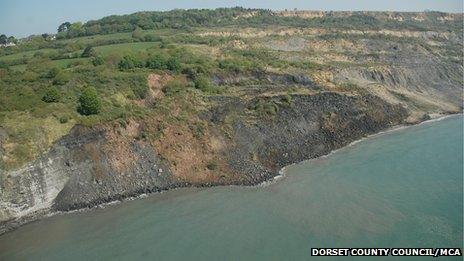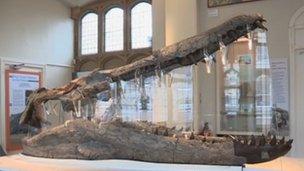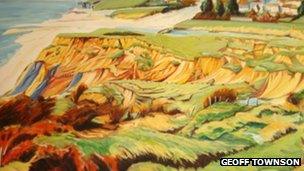Jurassic Coast: Safeguarding Dorset's eroding coastline
- Published

Erosion has uncovered fossils at Lyme Regis and Charmouth
There is a fine balance between allowing the Dorset coast to erode naturally and safeguarding people's lives, according to the Jurassic Coast World Heritage Site team.
This summer's rain caused large landslips along the coast including one on Monmouth Beach, Lyme Regis, and another in Burton Bradstock which claimed the life of 22-year-old Charlotte Blackman.
Work has started to protect over 400 homes in the eastern part of Lyme Regis from erosion. This will include the construction of a new 390m section of sea wall which begins next spring.
The advice from the county council is for people to stay away from the cliffs when visiting the Jurassic Coast - a warning which Portland Coastguard has said is sometimes ignored.
Pliosaur skull
Richard Edmonds, earth science manager for the Jurassic Coast World Heritage Site team, described the Dorset coast as "the county's greatest asset".
He said if it was not eroding it would not be as "beautiful, interesting and internationally important".

The fossilised skull of a pliosaur was discovered on the shores of Weymouth Bay in 2009
"Lyme Regis and Charmouth are famous because there are extraordinarily well preserved fossils there and they are uncovered by erosion," he said.
The most significant discovery in recent years was the 2.4m-long (7.9ft) fossilised skull of a pliosaur, a giant marine reptile, found on the shores of Weymouth Bay in 2009.
Mr Edmonds said a conflict arises when the erosion threatens people, property and infrastructure.
"It's quite interesting," he said, "engineers talk about protecting the coast from erosion, while we talk about protecting the coast from coast protection."
The latest phase of protection works in Lyme Regis will be paid for with £14.6m of government funding, £4.27m from Dorset County Council and £600,000 from West Dorset District Council.
The work includes the stabilisation of the steep slopes at Church Cliff and East Cliff.
Garden disappeared
Suzanne Whitemoor, 56 and her partner Derek Hallett, 70, have lived on Church Cliff for the past 14 years.
Six years ago part of their garden disappeared during a major landslip.
"The whole garden started ripping away - brambles and trees started sliding and the grass was turning over because the ground was falling from underneath it," Miss Whitemoor said.

Artist and geologist Geoff Townson has been painting Dorset landslips for 15 years
"We're not that far from the main road into Lyme Regis here, so if the cliff was to erode too much there'd be no way in or out of the town."
Although she described living at the property as being "worrying at times", Miss Whitemoor said she loved being there, describing the views along the coast to Portland as "absolutely fantastic".
Geoff Townson, a geologist and artist from Charmouth, is particularly attracted to this stretch of coastline because it is "constantly changing".
"Everyday is different and dependant on the seasons, the weather and the tides which is why it is so wonderful to paint," said Mr Townson.
"It's always on the move - part predictable and part unpredictable."
'Catastrophic' storm
The Jurassic Coast World Heritage Site team has been focussing one of its projects on the town of Charmouth where Mr Edmonds said the unpredictable nature of the coastline is what makes it "tricky" in terms of protection.
He said a large storm in the town would be "catastrophic" but added a storm of that kind "could happen tomorrow or not for another 50 years".
Nigel Robson, a watch manager at Portland Coastguard said the main rescues carried out after landslips were to people stuck in the mud or cut off from the tides.
He said: "We have seen a decrease in the amount of rescues in recent years which I hope is as a result of the warnings about the unstable cliffs.
"But there are occasions when we have warned people about hunting for fossils and climbing in the mud and they have just totally ignored us."
- Published14 August 2012
- Published12 August 2012
- Published9 August 2012
- Published26 July 2012
- Published12 June 2012
- Published8 July 2011